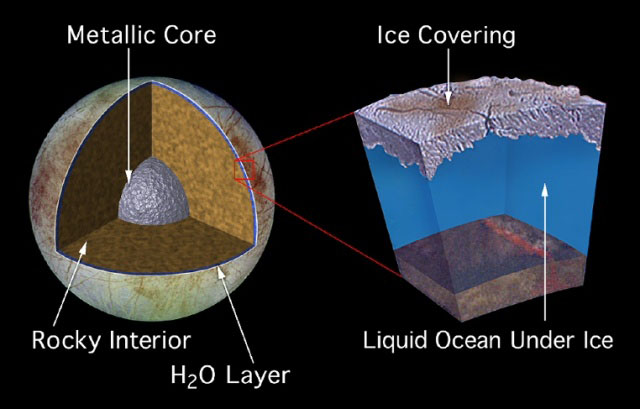Using data from the Jovian Auroral Distributions Experiment (JADE) instrument onboard NASA’s Juno spacecraft, planetary scientists have calculated the rate of oxygen being produced at Jupiter’s icy moon Europa to be substantially less than most previous studies.

This illustration shows charged particles from Jupiter impacting Europa’s surface, splitting frozen water molecules into oxygen and hydrogen molecules; scientists believe some of these newly created oxygen gases could migrate toward the moon’s subsurface ocean, as depicted in the inset image. Image credit: NASA / JPL-Caltech / SWRI / PU.
With an equatorial diameter of 3,100 km (1,940 miles), Europa is the fourth largest of Jupiter’s 95 known moons and the smallest of the four Galilean satellites.

The moon hosts an internal liquid ocean with potentially habitable conditions below a frozen crust.
Its surface is constantly bombarded by radiation that breaks the icy crust into oxygen and hydrogen, most of which are freed from the surface, escaping into space, or remain behind to form Europa’s atmosphere.
The abundance of these atmospheric gases and ions — and consequently their production rate at the surface — has mostly been inferred by remote sensing observations and has large uncertainties.

“Europa is like an ice ball slowly losing its water in a flowing stream,” said JADE scientist Dr. Jamey Szalay, a researcher at Princeton University.
“Except, in this case, the stream is a fluid of ionized particles swept around Jupiter by its extraordinary magnetic field.”
“When these ionized particles impact Europa, they break up the water-ice molecule by molecule on the surface to produce hydrogen and oxygen.”
“In a way, the entire ice shell is being continuously eroded by waves of charged particles washing up upon it.”

In the new study, Dr. Szalay and colleagues analyzed data from a flyby of Europa performed by the Juno spacecraft on September 29, 2022, which saw the spacecraft fly 353 km (219 miles) above Europa’s surface.
Using the JADE instrument, they extracted the abundance of various pickup ions, which are charged particles generated by the breakup of atmospheric neutrals when they collide with energetic radiation or other particles.
From these data, they calculate that approximately 12 kg of oxygen are produced at Europa’s surface every second.
/https%3A%2F%2Ftf-cmsv2-smithsonianmag-media.s3.amazonaws.com%2Ffiler_public%2F30%2Fee%2F30ee9357-26df-4740-90d0-81d52bd9efeb%2Fpia20025large.jpg)
This is at the lower end of the expectations inferred from previous models that ranged from 5 to 1,100 kg per second.
The results indicate there may be less oxygen on Europa’s surface than previously thought, and that this implies a narrower range to support habitability in Europa’s ocean.
“Our ability to fly close to the Galilean satellites during our extended mission allowed us to start tackling a breadth of science, including some unique opportunities to contribute to the investigation of Europa’s habitability,” said Juno’s principal investigator Dr. Scott Bolton, a researcher at the Southwest Research Institute.
“And we’re not done yet. More moon flybys and the first exploration of Jupiter’s close ring and polar atmosphere are yet to come.”